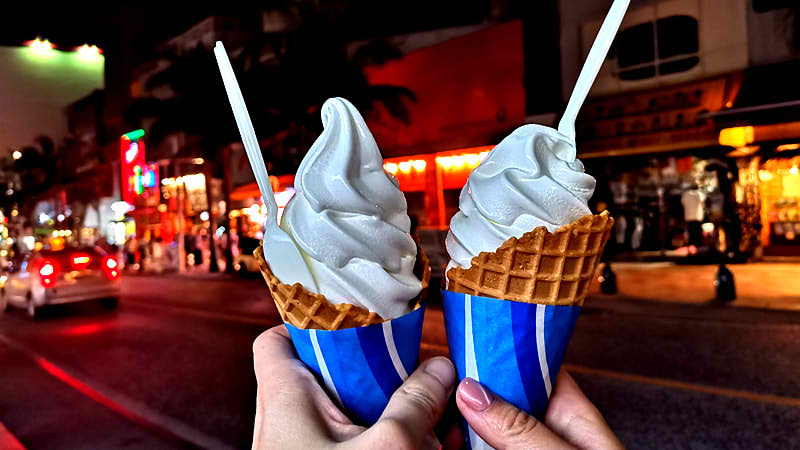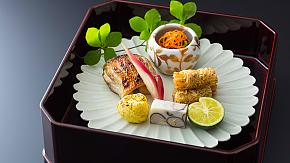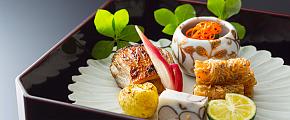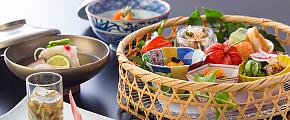Japan Street Food Adventure: What & Where to Eat
From savory yakisoba at festival yatai stalls to traditional hanami dango in delicate cherry blossom hues, Japanese food reflects the rich flavor of local culture - especially its diverse and flavorful street food, which varies by region. To make the most of your Japanese street food adventure, explore this gourmet on-the-go guide for a delicious and hassle-free Japan tour.
Can I Eat While Walking in Japan
You may have heard of the uniquely Japanese etiquette of tabearuki, which discourages eating while walking, making a street food tour in Japan both fascinating and a little worrying.
While this rule may observed in some busy areas around temples, shrines, trains, and subways (perfectly fine on Shinkansen or long-distance trains), most food markets and theme parks are places where eating while strolling is perfectly acceptable - especially during the lively summer festival and holiday seasons.
All in all, tabearuki (eating while walking) is not common among locals and is discouraged in certain areas. However, eating while walking is not prohibited by law in Japan. It is more of a cultural principle to avoid inconveniencing others with strong food smells, litter, or accidental spills that could stain clothing.
Observing and following local customs is always a good idea - handle your food carefully and be mindful of the environment around you. However, there's no need to feel guilty or ashamed about eating while walking, especially if your behavior is considerate and appropriate for the situation.
 Soft Ice Cream
Soft Ice Cream
Best Places to Try Japanese Street Food
Tsukiji Outer Market, Tokyo
Tsukiji Outer Market is not only a place to go for fresh seafood, but also one of the best places in Tokyo for street eats. It is best visited in the morning for a special brunch. You can start with a beef or tuna skewer to whet your appetite, followed by a tamagoyaki sando (egg sandwich) or onigiri (rice ball) stuffed with fresh seafood, then have a fruit daifuku (confection) for dessert - the street food hopping here never ends.
Nishiki Market, Kyoto
Known as the Kitchen of Kyoto, it is a large food market that stretches for about 400m, with hundreds of vendors selling fresh ingredients from vegetables to seafood, as well as local snacks to eat on the spot. Also with 400 years of history, Nishiki Market is an ideal place to sample some traditional flavors such as sweet mochi (rice cake), crispy senbei (rice crackers), and the popular tako tamago (octopus egg).
 Tako Tamago, Baby Octopu With Boiled Egg
Tako Tamago, Baby Octopu With Boiled Egg
Nakamise Dori Street, Tokyo
Located next to Sensoji Temple, Nakamise Dori is a lively street that stretches from Kaminarimon Gate to the main building. It is lined with around a hundred stalls selling handmade crafts and delicious street food, creating a festive atmosphere. You can stroll in front of the stores in a kimono while tucking into a candy apple or matcha soft serve, all while walking along the lantern-lit street filled with the scent of sweets and incense.
Dotonbori, Osaka
Lined with countless eateries and drinking spots on both sides of the canal, Dotonbori is a vibrant entertainment and food district where you can indulge in the authentic flavors of Japan by hopping from stall to stall. From morning to night, you can treat yourself to a variety of restaurants and savor iconic street foods like takoyaki as you explore this lively cityscape with its dazzling neo-lights reflected on the waterfront.
Nakasu Yatai Yokocho, Fukuoka
Typically open from around 6 pm to 2 am, the traditional open-air food stalls of yatai in Fukuoka provide the ultimate street food atmosphere - with the multi-smell of delicacy, cooking noise, and lively chatter, all set against the scenic night views along the river. You can sample a variety of simple yet satisfying dishes from each stall, or settle into a yatai seat to enjoy a bowl of ramen or a cup of sake, savoring the flavors and enjoying the long evening.
Popular Japanese Street Food You Must Try
Yakitori - Grilled Chicken Skewer
Yakitori, or grilled chicken skewer, is a popular choice for street food in japan, often sold from small carts or yatai, and perfect for enjoying while sightseeing. Seasoned with sweet sauce and salt and freshly grilled over a charcoal fire, offering a juicy bite with an addictive smoky flavor.
The wonderful taste can also make you appetize for more bites. From drumsticks to wings, meatballs to breast, there are various cuts to suit your taste. If you are not in a hurry, pairing them with a cold beer or sake makes for a perfect, relaxed meal.
 Yakitori, Grilled Chicken Skewers
Yakitori, Grilled Chicken Skewers
Takoyaki - Octopus Ball
Often considered the quintessential street food of Osaka, takoyaki is a ball-shaped savory snack made from a wheat flour batter, filled with chopped octopus and onions. It offers a delightful contrast of crispy on the outside and soft and gooey on the inside.
Besides the delicious taste, it's also fun to watch skilled craftsmen flip and shape the batter into perfect spheres before adding toppings like laver and bonito flakes. The bite-sized balls are easy to eat and perfect for sharing with friends and family. Just remember to let them cool a bit before taking your first bite!
 Takoyaki, Octopus Balls
Takoyaki, Octopus Balls
Taiyaki - Fish-Shaped Cake
Although the ingredient has nothing to do with fish, taiyaki is a fish-shaped pancake with a warm filling of red bean paste, chocolate, or custard. It is a popular sweet treat that best suits a walk outdoors, with the autumn leaves and cool breeze warming your body with each hot bite.
As for the fish shape, the tai (red sea bream) is a symbol of good luck and happiness in Japan. During your street food tour of Japan, you may also find other yaki sweets in different shapes, such as ningyo yaki in doll shape.
 Taiyaki, Fish-Shaped Cakes
Taiyaki, Fish-Shaped Cakes
Mochi - Japanese Rice Cake
Mochi, a soft rice cake, is another visually appealing street food in Japan, especially when made traditionally - one person pounds steamed rice with a wooden pestle while another rhythmically turns and moistens the mochi.
Although once a traditional food served at New Year's, mochi is now enjoyed all year round as an ingredient in a variety of treats. You can enjoy freshly made warm mochi sprinkled with powdered sugar, in a traditional sweet mochi soup with red bean, or try daifuku - mochi ice cream wrapped in chocolate, fresh fruit, or bean paste.
Dango - Skewered Rice Dumpling
Dango, a classic Japanese street food often featured in films, games, and anime, is a quintessential representation of Japan. These small, ball-shaped wagashi are made from rice flour, offering a chewy, toasty texture similar to mochi but with a smoother bite.
Dango is typically served in two varieties: the sweet version, often paired with green tea or matcha, such as the 3-color Hanami Dango (pink, white, and green, symbolizing cherry blossoms); and the savory like Mitarashi Dango, grilled over charcoal and glazed with soy sauce, perfect for satisfying your savory cravings.
 Savory Mitarashi Dango
Savory Mitarashi Dango
Japanese Crepes
Thinner, larger, and folded into a cone, Japanese crepes are as easy to hold as ice cream. No wonder they're a popular street food in Japan, especially in Harajuku, Tokyo.
Typically filled with fresh fruit and whipped cream, then delicately topped with scoops of ice cream, colorful candies, and a drizzle of sauce, crepes often call for a 'camera-first' moment before taking your first bite. To fully enjoy the flavors, ask for an extra spoon to scoop up the toppings first, then enjoy the crepe itself as it soaks up the delicious cream.
 Japanese Crepes
Japanese Crepes
Korokke - Potato & Meat Croquette
Korokke is a beloved staple in Japanese households, but its crispy, juicy texture - featuring a blend of tender meat, creamy mashed potatoes, chopped vegetables, and a coating of wheat flour, egg, and breadcrumbs - also makes it a perfect street food snack to enjoy before a main meal.
Deep-fried to a golden brown in hot oil, korokke is easy to spot by its tantalizing aroma and the sizzle of frying. At these stalls, you might also find other fried delights like karaage (Japanese fried chicken) and tempura (crispy vegetables or shrimp), offering a variety of flavors to satisfy your cravings.
Yakisoba - Stir-fried Noodles
Yakisoba, stir-fried wheat flour noodles with pork and vegetables, is a popular street food among locals. It's often found in narrow alleys, near temples and shrines, and is a popular item at festival stalls and matsuri yatai.
While chopsticks are the traditional way to enjoy this savory dish, there's a unique twist to eating it on the go-yakisoba pan (yakisoba bread). This carbohydrate-on-carbohydrate creation uses stir-fried noodles as a filling for a soft bread roll, making it convenient to enjoy as you stroll in search of your next treat.
 Yakisoba, Stir-fried Noodles
Yakisoba, Stir-fried Noodles
Japanese Street Food Tips
Attention to Sign & Signage
It's worth noting that outside of designated tabearuki areas, eating while walking is generally discouraged in Japan. If you come across food stalls offering tempting treats, check the signs around you or observe local behavior to see if eating while walking is allowed. If it's not, simply enjoy your meal at the stall before moving on to the next one.
Do with Your Rubbish
Although Japan surprisingly lacks public garbage cans, you'll often find some provided by food stalls for disposing of waste from your quick meals. Simply toss your trash there after eating, or carry a small plastic bag with you just in case.
Prepare Some Small Cash
Most street food stalls, particularly the yatai in Fukuoka or during the festival celebrations, are typically cash-only. It's highly recommended to carry some small bills or coins to ensure a smooth and enjoyable street food journey in Japan.
 Yatai Food Stall
Yatai Food Stall
Start Your Street Food Adventure in the Afternoon
Most food stalls and vendors typically open in the late afternoon, around 5 or 6 PM. Starting your foodie tour in Japan after a leisurely afternoon nap or just before tea time is a great way to sample various flavors with fewer crowds and shorter lines. For those seeking a livelier atmosphere to enjoy your meal, around 6 to 8 PM is the ideal time to dive into the vibrant street food scene.
Enjoy Your Tasty Japan Street Food Tour With Odynovo
What's your favorite flavor? Are there any must-try dishes already on your itinerary? Or perhaps you have any allergens to avoid? Whatever your preferences or questions about Japanese food or your upcoming trip, please do not hesitate to contact Odynovo at [email protected]. We're here to help you plan a Japan tour to suit your tastes!
Related Posts You May Like
What Our Clients Say
Explore the latest verified reviews of Odynovo's travel services on Tripadvisor, Google, Trustpilot, Product Review and more trusted platforms.










